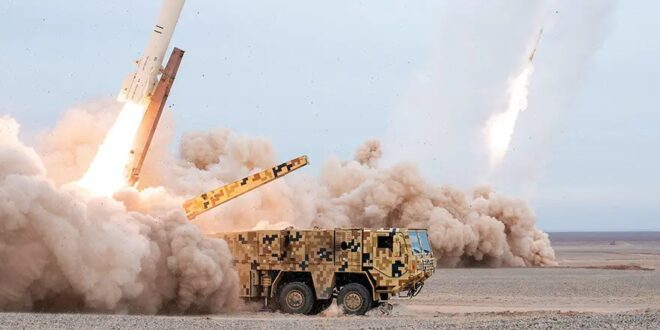Iran will be hoping that it has reinforced its credibility in the Middle East with its attack on Israel, but it is more likely to prompt a damaging Israeli response.
It will take time for both confirmation and reliable assessments of damage on the ground to come out, but at the moment and based on various government briefings, it appears that between 180 and 200 ballistic missiles were launched from Iran at several targets in Israel on the evening of 1 October. This is nearly double the number of ballistic missiles involved in Iran’s attack in April. At the time of writing, there do not appear to have been any accompanying cruise missiles or drones, including anything launched from Lebanon by Hezbollah.
What Missiles and What Targets?
Images emerging from inside Iran, along the flight route and inside Israel suggest that the missiles were probably Emad and Ghadr-1 medium-range ballistic missiles (variants of the Shahab-3) and possibly the newer Fattah-1 (which Iran has described as a ‘hypersonic missile’, even though it is probably better characterised as a medium-range ballistic missile).
The targets appear to include Nevatim airbase (which was also attacked in April) and Tel Nof airbase, as well as possibly the Mossad headquarters in Tel Aviv and other areas in and around Tel Aviv.
How Well Did Israel and its Allies Intercept Iran’s Missiles?
It’s difficult to draw conclusions on the successes and failures of Israel’s missile defences at this point, though both Israeli and US sources are calling the damage ‘minimal’. It is likely that the early warning system worked well, since the Israeli Home Front Command was able to get people into shelters quickly and minimise casualties (and it seems that a Palestinian hit by debris near Jericho was the only fatality).
Israel can’t be in the position of tolerating direct attacks from ballistic missiles on its territory, especially if those attacks increase in scale and begin to put pressure on its missile defence systemVideo and photographs show multiple impacts on the ground, especially at Nevatim, and there were certainly more impacts and visible terminal phase intercepts (that is, very late in the flight of the missile) than in Iran’s previous attack. At this stage it is unclear what proportion of the Iranian attack got through the exo-atmospheric (outside the atmosphere) and upper endo-atmospheric (top of the atmosphere) tiers of Israel’s missile defence system, where most intercepts of medium-range ballistic missiles should occur; there is at least one video appearing to show a possible exo-atmospheric interception. It should be noted that this defence would mostly involve Arrow-2 and Arrow-3, rather than the more widely known Iron Dome, which focuses on rockets and drones.
In terms of international involvement, the US has confirmed that two of its Arleigh Burke-class destroyers in the Eastern Mediterranean fired a dozen interceptors (probably Standard Missile 3) at incoming missiles. The UK Ministry of Defence has said that UK forces ‘played their part’. RAF Typhoons are not well-equipped to shoot down ballistic missiles, and although a Type 45 destroyer (HMS Duncan) is in the region, no confirmation has been given that it used its Sea Viper missiles, so it’s possible that the UK instead provided intelligence, surveillance or other tracking data.
Early impressions are that only a relatively small proportion of the 180–200 allegedly fired made it through to impact targets, so the combination of Arrow and (probably) US Standard Missile 3 as well as the David’s Sling system as a lower-tier defensive system probably had a high intercept rate. However, this is only a preliminary view, and both the scale of the attack and the apparent penetration by even some missiles show that this was a serious attempt to damage Israel. It may be notable that – unlike in April – the ballistic missiles were not accompanied by drones launched from Iran, nor any coordinated attacks from inside Syria, Iraq, Yemen or Lebanon, suggesting either that it was unable to coordinate with its proxies and partners, or that such capabilities were not seen as worth adding to the attack for the risk of being struck in return.
Will this Affect Israel’s Military Operations against Hezbollah?
It’s unlikely that this attack will have any impact on the ground operation in Lebanon, and more forces have already been called up to support that if necessary. The Israel Defense Forces have released video of operations overnight, plus the destruction of some of Hezbollah’s tunnel infrastructure and weapons/ammunition storage. The pace of those operations will be determined by the target list and the extent to which Hezbollah fighters on the ground resist or fall back; after initial unopposed advances, reports are now emerging of the first casualties as part of the ground campaign.
Israel will need to continue launching airstrikes further north if it wants to reduce Hezbollah’s longer-range precision missile stockpile or strike new leadership targets. The tempo of operations has already dropped off significantly from the first 48 hours of the Lebanon offensive, but if Israel decides to launch a major strike against Iran in the near future, it might reprioritise aircraft away from Lebanon temporarily, depending on the stress currently on the Israeli Air Force and its ability to maintain current sortie rates.
How Might Israel Respond Militarily against Iran?
The apparent lack of Israeli casualties might limit the pressure inside Israel for a particular type of response, though we have yet to see the damage on the ground at Israel’s military facilities. However, Israel can’t be in the position of tolerating direct attacks from ballistic missiles on its territory, especially if those attacks increase in scale and begin to put pressure on its missile defence system. Some kind of Israeli response is therefore almost inevitable (and indeed has already been promised). At the lower end of the spectrum would be a reminder of its conventional superiority, striking Iranian military targets in order to emphasise and widen that gap, such as missile defence and radar sites inside Iran. Israel’s response to the April attack was to destroy an S-300 air defence system near the nuclear facility at Esfahan, sending a double message, so a larger such attack may be necessary on this occasion. Hitting ballistic missile production, storage or operation sites would also serve the dual purpose of widening the gap and removing threats to Israel.
However, with Iranian deterrence reduced by the weakness of its proxies and partners, there are already some who are calling for striking more directly at the regime; this puts other wider military targets in the crosshairs, such as major (especially Islamic Revolutionary Guard Corps) facilities. Moving up the scale, ports or Iranian infrastructure, including oil production facilities, could be attacked to emphasise the damage that Israel can do to Iran. At the top end would be senior Iranian officials and the Iranian nuclear programme. The latter is challenging; on the one hand, Iran has expanded its uranium enrichment volume and purity to the extent that it might only take a few weeks to have sufficient uranium enriched for a weapon. On the other hand, there isn’t any evidence that it has a weapon or delivery system ready. A strike now might encourage Iran to believe that weaponisation is its only remaining defence. This would also be true if the scale of any strikes against the wider military or leadership makes it think the threat is existential. In addition, Israel alone can inflict serious damage to Iran’s nuclear facilities, but it probably can’t destroy the deepest-buried ones without US assistance. Nonetheless, the mood in Israel may encourage some to believe that setting the Iranians back by years is a prize for which it is worth taking some risks.
It appears that Iran has attempted to thread the eye of the needle in launching an attack that restores its credibility and reaffirms its support for its partners and proxies in the regionOptions for covert sabotage, cyber operations or more targeting of Iranian proxies across the region are available, but these are more likely to be focused on current threats, and planned already. They may not meet the threshold to be considered ‘strong’ enough as a response to a massed ballistic missile attack, and so will be triggered by Israeli calculations on the necessity of reducing existing risks.
Overall, it appears that Iran has attempted to thread the eye of the needle in launching an attack that restores its credibility and reaffirms its support for its partners and proxies in the region, but without triggering a massive Israeli response. The lack of obvious casualties may help, but if Iran is hoping to avoid Israeli retaliation it is likely to be sorely disappointed. While the sight of several dozen ballistic missiles striking Israel may play well in some domestic Iranian constituencies, they pose a challenge that Israel can’t leave unanswered. Over the course of the past year, Iran and its proxies have increasingly misread Israel’s tolerance of risk. For its part, Israel is faced with the apparent opportunity to strike a once-in-a-generation blow against Iran and its partners, although this is not guaranteed to resolve the issue. The scope and scale of its response are therefore hard to predict with all of these factors in play, but it is likely to be painful for the Islamic Republic nonetheless.
 Eurasia Press & News
Eurasia Press & News




